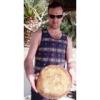
Some Weekend Home Bread Baking and the College "Equality and Diversity Competition" Entry from a student Bakery Group.
Equality and Diversity Competition
My Level 2 Bakery students are very competitive. Following on from Faye's Nettle Bread, and their determined, difficult yet successful adventures into Practical Exams, the group came up with a theme for their own entry into the College's Annual Competition:
"Breads of the World Arise"
See if you can name some of the breads, and where they come from?
We then worked together to produce a lovely basket and Cornucopia to house the finished loaves.
This was to ensure we made it through to represent our School in the College-wide competition....which we did!! Some people in this group won the competition outright last year; they seem to be equally determined to repeat their previous success! Let's wish them well.
And, here's some recent home bread making.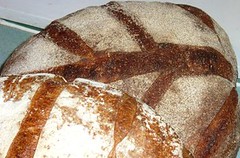
1. Pain de Siègle
|
Material |
Formula [% of flour] |
Recipe [grams] |
|
1. Rye Sour |
|
|
|
Dark Rye |
16.67 |
150 |
|
Water |
27.78 |
250 |
|
TOTAL |
44.45 |
400 |
|
|
|
|
|
2. Final Dough |
|
|
|
Rye Sour [from above] |
44.45 |
400 |
|
Strong White Flour |
83.33 |
750 |
|
Salt |
1.8 |
16 |
|
Water |
40.22 |
362 |
|
TOTAL |
169.8 |
1528 |
|
% pre-fermented flour |
16.67 |
- |
|
% overall hydration |
68 |
- |
Method:
- Build the sourdough from stock over 2 refreshments and 36 hours
- Combine sour with flour and water and autolyse 45 minutes
- Continue the mixing cycle by developing the dough and adding the salt to form a strong dough.
- Ferment in bulk for 2 hours, with 1 S&F after 1 hour
- Shape and proof in a banneton for 3 hours prior to baking
- Cut the loaf top and bake with steam for 50 minutes to 1 hour
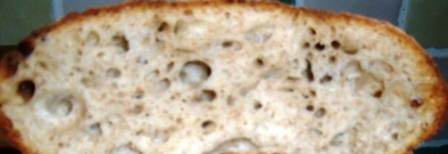 >
> 

Chewy and moist Sandwich bread made with a natural leaven and a retarded fermentation process
|
Material |
Formula [% of flour] |
Recipe [grams] |
|
1. Wheat Levain |
|
|
|
Strong White Flour |
29.4 |
250 |
|
Water |
17.6 |
150 |
|
TOTAL |
47 |
400 |
|
|
|
|
|
2. Final Dough |
|
|
|
Levain [from above] |
47 |
400 |
|
Strong White Flour |
70.6 |
600 |
|
Salt |
1.65 |
14 |
|
Water |
50.4 |
428 |
|
TOTAL |
169.65 |
1442 |
|
% pre-fermented flour |
29.4 |
- |
|
% overall hydration |
68 |
- |
Method:
- Build and mix as above
- Bulk ferment for 2 hours, then shape loosely and retard overnight in the chiller
- Shape and proceed to final fermentation and baking, as above.
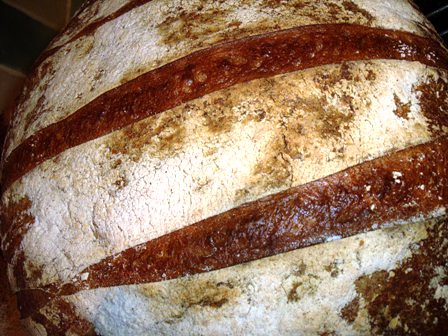
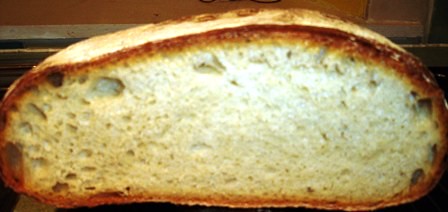
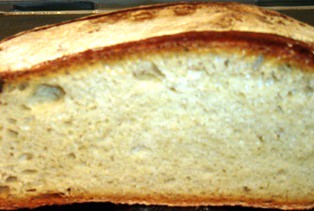
Both of these are really tasty breads for our daily sandwiches whilst at work!
Best wishes to all
Andy

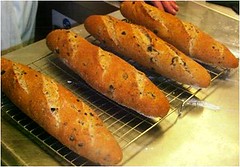
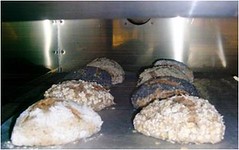
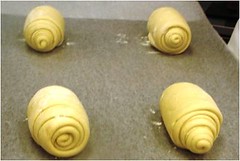
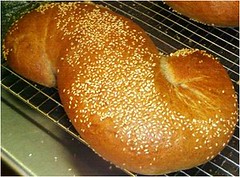
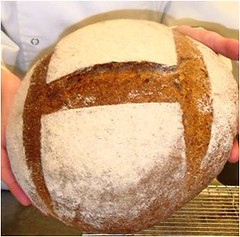
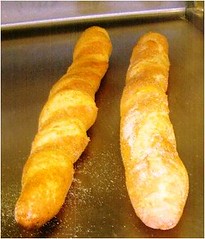


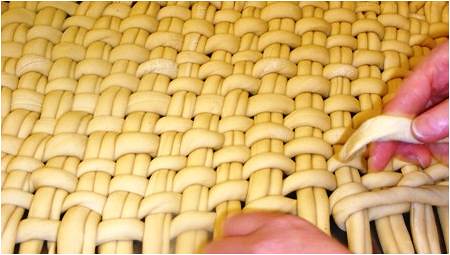

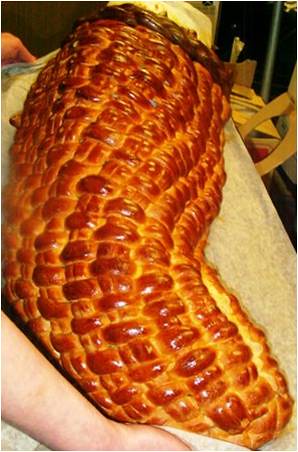
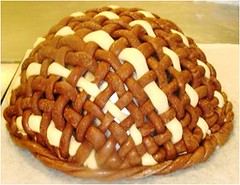
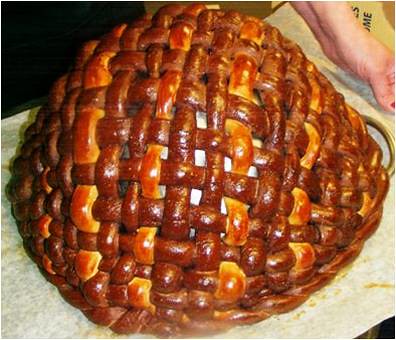
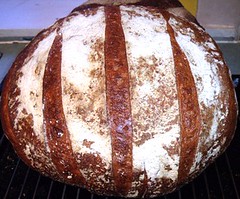


Comments
I can't help but admire the results you got on your loaves. I'm still working on getting crusts as good as yours. However, I can't follow how you built your rye sour and levain. I don't see any sourdough starter or other source for yeast. Are your flours so copious in natural yeast spoor that the sour and levain are up and running overnight or did I miss something in your procedures? It appears that you get great results with less work and I'd like to know how that's done.
Hi postalgrunt,
Thank you for commenting and asking this question.
I haven't been finding time to record each refreshment regime as I bake at home. So, the totals in the leavens above are for both flour and water as found in the fresh addition plus that used from stock.
I keep both a rye sourdough and a wheat leaven in stock in the fridge in lidded plastic containers. Approx 80g of stiff wheat levain [50g flour and 30g water]. Approx 80g Liquid Rye Sour [30g flour and 50g water]
Generally I build over 2 refreshment cycles. These can be complex, as they take into account numerous factors, such as baking schedule, current weather conditions and the state of the cultures drawn from stock.
However, on this occasion I fed the wheat leaven as follows:
Leaven Refreshment Cycle March 2011
Day & Time
Materials
Weight [g]
Constituent parts
Saturday am
Stock Leaven
32
20g flour, 12g water
Let down to a liquid
Strong White Flour
68
leaven to promote
Water
68
wild yeast activity
TOTAL
168
88g flour, 80g water
Sunday am
Leaven [above]
168
88g flour, 80g water
Balance flour and
Strong White Flour
162
water to return
Water
70
to 100:60 ratio
TOTAL
400
250g flour, 150g water
I then used 320g of this leaven to make the dough on Sunday evening. I fermented this for 2 hours, then retarded overnight in the chiller. I then baked it off on Monday afternoon.
For the rye sour, I was a little short of rye flour, and thought I would try to just use a single refreshment, on Saturday am as follows:
Material
Weight [g]
Rye Sour from stock
80
30 flour, 50 water
Dark Rye Flour
150
Water
250
TOTAL
480
180 flour, 300 water
400g then used in the bread dough, and 80 held back for stock
I used this on Sunday am to make the Pain de Siègle dough
Sorry, you can see how much work I put in here. There is no easier procedures giving the desired results. But, yes, my leavens are good and active once I've fed them up properly.
Thanks
Andy
Hello Andy,
Congratulations to your students and it is so nice to see those 'breads of the world', and those cornucopias with such even weaving.
I love the crumb on your pain de siegle and your white leavened bread looks very pretty with that rich dark crust and scoring.
I've admired your pain de siegle loaves you've posted about previously.
I was curious as to how you built up and refreshed your rye sour too but was shy to ask; I looked back in your blog and saw your post about 'leaven refreshment' and wondered if I could use the rye sour percentages as you list there as a starting point.
Thanks Andy for your post, with all of these beautiful loaves.
from breadsong
Hi,
I've given refreshment details above for postal grunt. Hope this answers your question too. I still wish I'd split the rye refreshment into 2 feeds. It would have given me a stronger leaven.
Yes, the student loaves are great. The fruited loaf is not, as Franko suspects! It is in fact the Elizabeth David version of Bara Brith as you posted on recently. However, I worked with the student concerned to add in the use of a ferment like we do for most of the doughs I teach here in College. Sadly, we didn't keep the calculations. I had intended to e-mail you with it...now there's an admission!
All good wishes
Andy
Thanks for the providing the information re: leaven.
I appreciate also your thought re: re-working Bara Brith to employ a pre-ferment & it's a good idea I should try next time.
Along with the Bara Brith I took note of a 'quarter-sponge' method Ms. David wrote about in her book which looks interesting...I tried to distill the very large quantities written into baker's percentages...may try it out as a pan loaf. But I think I'd like to try making your beautiful Pain de Siegle first!
Thanks for providing the names and details regarding all of those breads.
I quite like the Pane a Pasta Dura...and found an Italian video on shaping...hope you don't mind if I post the link here:
http://www.youtube.com/watch?v=9ZmVUc46yag
Thanks so much,
from breadsong
Hi Breadsong,
I thought you might find some of the text below of interest. I've edited it a bit, as it comes from personal mail with another TFL member. Please make allowances for this context.
I liked the video on You Tube, thanks for adding the link.
Text below:
Best wishes
Andy
E-mail 1
I don't tend to use the term "seed" myself, but I am familiar with what you are trying to get to understand.
So, we are talking about the amount of flour in what I think of as "stock" sourdough, held in the chiller, and used to elaborate the culture to be used to leaven the final dough/paste?
5% is really no problem, given a good feeding regime and an established and active sour culture. Jeffrey Hamelman is particularly expert in this, and I would refer you to his section on "Detmolder" for further reading and understanding here.
Let me try and illustrate this with how we made our Russian Rye "Rossisky" when I worked at Village Bakery back in the 1990s.
ROSSISKY
MATERIAL
Formula [% of flour]
Recipe [kg]
1. Rye Sourdough
Stock/Seed
-
2.4 [900g flour, 1.5kg water]
Dark Rye Flour
33.3
20
Water
55.5
33.3
TOTAL
88.8
55.7
Back to stock
2.4
2. Final Paste
Rye Sour [from above]
88.8
53.3
Dark Rye Flour
66.7
40
Salt
1.67
1.0
Water
29.5
17.7
TOTAL
186.67
112
Percentage figures are shown in the middle column, but the recipe is of most interest.
The stock/seed amounted to nothing more than the scrapings inside the tub which contained the sourdough. We held at least 10 of these containers fully stocked at any one time! [That's half a tonne]
The newly refreshed tub of sour had a combined temperature of 30°C, and was left to ferment through for 16 hours. So, 900g of flour in the seed was sufficient to inoculate 20kg of flour in the elaborated culture. That is 0.9kg/20.9kg x 100 = 4.3% Because we had a constant refreshment regime combined with a proper fermentation system, there were rarely any problems. When problems arose, it was either due to excess production pressure, or, poor quality flour [that's a side issue here]
From there, we made up the final paste 16 hours later with the addition of 40kg more fresh flour, but with a tiny portion held back for the next refreshment. So, approximately, 900g of flour produced a final sour with 20kg of flour, then 40kg more flour to the final paste. 0.9/60 x 100 = 1.5% flour!!
I write to demonstrate the utmost extreme. But we made 000s of these loaves per week. Hamelman writes as a production baker, with a sour dough I believe he says is over 30 years old. VB sour came from Russia and was 150 years old. Reinhart is assuming a home audience, I believe.
I think you need to work through the following.
E-mail 2
Clarification on VB Rye feeding regime: 2.4kg "seed" [contains 900g flour, 1500g water] is feed with 20kg of flour and 33kg of water.
Yes, you did read that correctly!!
Now for the qualifier: we had 16 bins of rye sour on the go at any one time, and each of the bins contained in excess of 50kg as described above. We made over 1000 loaves each day of Rossisky and Borodinsky combined. So; lots and lots of bread production, producing extremely vigorous culture.
I think you may struggle to really appreciate the volumes involved here.
Then I note you want to keep your cultures ambient rather than stored in the fridge. I keep both my rye and wheat leaven at home in the fridge. Then, I use a proper feeding regime to bring them to full activity before I use them to make bread. Such as the Detmolder method described by Hamelman. I've never really been one for the ratios, although I can see their intention. Main key to me is to achieve the fundamental balance Jeffrey Hamelman describes so well. NATURAL [wild] YEAST, ACETIC and LACTIC BACTERIA. You need them all! So in an 18hour ferment of the size and consistency I describe for the VB production, these conditions were a given. In the home environment, this is not quite the case. Nonetheless, rye is eminently fermentable, especially wholegrain. So, a couple of feeds, over a 2 day period, and you won't be wide of the mark.
Final word; I don't retard rye paste; unlike a recent thread advocates. It just hasn't worked for me for all-rye breads.
E-mail 3
stick with the ratios if it works for you.
I'm a total stickler for wanting to know the precise amount of pre-fermented flour used in the formula, and the hydration. I never, ever guess anything...unless forced to by the circumstances [ie a rare occasion when no digital scales are available.
Hello Andy, I really appreciate you going through your mail archive on my behalf and pulling out this very useful information. It's fascinating to read about the quantities involved in a production bakery, and thanks for the advice regarding the process as it would apply to home production.
I will go back and re-read Mr. Hamelman's writing on Detmolder.
...and I'm glad you liked the video. :^)
Thanks so much, from breadsong
I think # 5 might...maybe be an Occhi di Santa Lucia from a Pane di Siciliano dough, but a guess at best. #6 looks like it could be a Tartine Country Rye, and #7 looks to be a Panettone.
The cornucopia weaving is excellent with the dual strand running from end to end , giving a very nice look to the overall presentation. Your students work looks lovely, and all of them should be very proud of what they've achieved. Quite a testament to the level of training they're receiving from you Andy. Well done on all accounts!
Both of your own breads look marvelous, particularly the Pain de Siegle with it's beautiful open celled crumb and rich brown crust. I'm sure you're looking forward to firing your WFO in the not too distant future now that things are warming up. Hey! Spring is just about here my friend.
Best Wishes,
Franko
Hi Franko,
Here's the list, left to right
Top Row: Olive Baton, final proof, then baked, Irish Soda Farls baking in the oven
Middle Row: Pane a Pasta Dura*, Pane Siciliano, Hadrian Bread**
Bottom Row: Baguette Traditional, Bara Brith [see note to Breadsong]
My contribution to the piece was the Borodinsky loaf from the previous blog post. Only half of it ended up in the Cornucopia, as the students continuously snacked on it through the morning session!
* Giuseppe is from Sicily. He tells me this is the "generic" name for this bread. It is quite unusual to us, but, I guess is easy to relate to when we think of the rusk so common in the hot Southern Mediterranean areas. The dough has just a short bulk proof. Then it is rolled out thinly several times, and folded, then rolled up very tight. This creates a lovely seashell type pattern on the finished loaf. It is baked out very fully, on a low heat to intentionally dry out the close-textured crumb. Locally Giuseppe says in the South, in Catania it is called "Panuzzu". In Genova it is called "Biove" and in the North in Treviso, it is called "Pan Trevisan"
**Hadrian Bread: this is made using Spelt flour and an idea borrowed from my time at Village Bakery when Andrew Whitley created a sour dough loaf using Spelt flour...way back in the late 1990s, just as Spelt was at the very beginning of its resurgence. There is a Raisin "must" in the formula to provide sweetness to balance the bitterness sometimes found in Spelt. We used Spelt flour from our local organic mill Gilchesters...entirely appropriate given it is just a few miles from Hadrian's Wall! But this loaf was designed by Katie, who has become a champion of Beer Balm, using bottled traditional stout from the wild outer regions of Northumberland. Winner!
Had to add an erratum to this post. Time to take a look at your work on the Spreadsheet methinks!!!
Wonderful to hear from you, as always
Andy
Getting 1 out of 8 pretty much describes my luck in the lotteries to a T, so not a big surprise to me.
Good to hear from you as well Andy.
Franko
Your Pupils are as determined as you are Andy! Lovely Work, especially that hand weaving of pain de morte..
Your pain de seigle, however, is wondrous to look at! The light and camera do not do them justice... you are better off without flash, as it imparts a yellowish cast which hides the true texture of your breads..
Hi Khalid,
Thank you for your kind words.
Your photographic advice is much appreciated. Sadly it is very gloomy here in the UK just now. Additionally, the bread has been coming out of the oven as darkness starts to fall. I'm not sure I'd get away without flash but I can give it a try
Best wishes
Andy
My apologies, this is the correctly balanced formula here. I forgot that I held back 80g of leaven as my stock for next time! Doh!
White Leavened Bread
Chewy and moist Sandwich bread made with a natural leaven and a retarded fermentation process
Material
Formula [% of flour]
Recipe [grams]
1. Wheat Levain
Strong White Flour
25
200
Water
15
120
TOTAL
40
320
2. Final Dough
Levain [from above]
40
320
Strong White Flour
75
600
Salt
1.75
14
Water
53
424
TOTAL
169.75
1358
% pre-fermented flour
25
-
% overall hydration
68
-
Many thanks
Andy